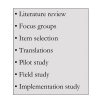The European DISABKIDS project: development of seven condition-specific modules to measure health related quality of life in children and adolescents
- PMID: 16283947
- PMCID: PMC1326227
- DOI: 10.1186/1477-7525-3-70
The European DISABKIDS project: development of seven condition-specific modules to measure health related quality of life in children and adolescents
Abstract
Background: The European DISABKIDS project aims to enhance the Health Related Quality of Life (HRQoL) of children and adolescents with chronic medical conditions and their families. We describe the development of the seven cross-nationally tested condition-specific modules of the European DISABKIDS HRQoL instrument in a population of children and adolescents. The condition-specific modules are intended for use in conjunction with the DISABKIDS chronic generic module.
Methods: Focus groups were used to construct the pilot version of the DISABKIDS condition-specific HRQoL modules for asthma, juvenile idiopathic arthritis, atopic dermatitis, cerebral palsy, cystic fibrosis, diabetes and epilepsy. Analyses were conducted on pilot test data in order to construct field test versions of the modules. A series of factor analyses were run, first, to determine potential structures for each condition-specific module, and, secondly, to select a reduced number of items from the pilot test to be included in the field test. Post-field test analyses were conducted to retest the domain structure for the final DISABKIDS condition-specific modules.
Results: The DISABKIDS condition-specific modules were tested in a pilot study of 360 respondents, and subsequently in a field test of 1152 respondents in 7 European countries. The final condition-specific modules consist of an 'Impact' domain and an additional domain (e.g. worry, stigma, treatment) with between 10 to 12 items in total. The Cronbach's alpha of the final domains was found to vary from 0.71 to 0.90.
Conclusion: The condition-specific modules of the DISABKIDS instrument were developed through a step-by-step process including cognitive interview, clinical expertise, factor analysis, correlations and internal consistency. A cross-national pilot and field test were necessary to collect these data. In general, the internal consistency of the domains was satisfactory to high. In future, the DISABKIDS instrument may serve as a useful tool with which to assess HRQoL in children and adolescents with a chronic condition. The condition-specific modules can be used in conjunction with the DISABKIDS chronic generic module.
Figures
References
-
- Andelman RB, Zima BT, Rosenblatt AB. Quality of Life of Children: Toward Conceptual Clarity. In: Maruish ME, editor. The use of psychological testing for treatment planning and outcomes assessment. Mahwah, NJ, Lawrence Erlbaum; 1999. pp. 1383–1413.
-
- Eiser C, Morse R. Quality-of-life measures in chronic diseases of childhood. Health Technol Assess. 2001;5:1–157. - PubMed
-
- Bender BG. Measurement of quality of life in pediatric asthma clinical trials. Ann Allergy Asthma Immunol. 1996;77:438–445. - PubMed
Publication types
MeSH terms
LinkOut - more resources
Full Text Sources
Medical



